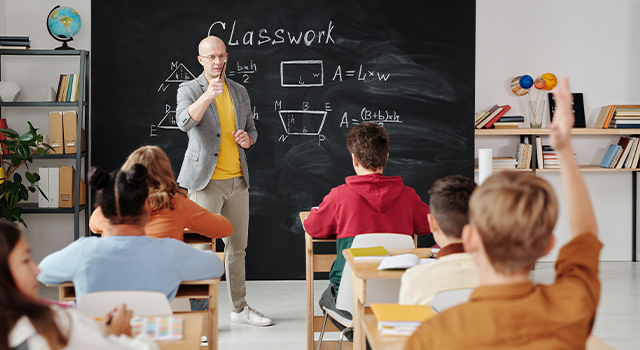
Why Vision Screening is Not Enough
Did you know that your child needs to master 17 different visual skills to succeed in reading, learning and sports? Basic vision screening results don’t test for any of these skills and therefore are not sufficient to rule out all vision problems possibly impacting your child.
The purpose of pediatric vision screenings is to detect refractive errors and eye diseases, not to identify a lack of vital vision-related skills. Undiagnosed vision problems, including reduced vision skills, cause one in ten children to experience learning difficulties and can impact other areas in life, such as sports.
Provide your children with the care and tools needed for better vision and successful learning. Contact Dr. Sophie Jobin for a functional vision exam to assess their full range of vision functionality and determine the adequate treatment options needed to improve your child’s school and sports achievements.
Vision Screenings Don’t Reveal Much
Basic vision screenings, such as those offered at schools, usually test only for visual acuity — the sharpness of vision in each eye. Some may include additional tests such as lazy eye, eye coordination and color blindness. Though your child may pass all vision screening exams with flying colors and may excel in seeing the vision charts, he or she may still struggle with visual-motor skills, eye tracking skills, have poor peripheral vision, or have other undetected vision problems.
Following a vision screening, many questions may remain unanswered: does your child have sufficient control over eye movements? Are both eyes properly aligned when focusing? How is your child’s depth perception? These are but a few of the skills that play a critical role in learning and functioning at our best in this fast-paced world.
What Symptoms Should You Look Out For?
As a parent, it is critical that you remain alert to any behavior that could signal a vision issue. Keep an eye out for any of the following symptoms and ask teachers to do the same.
- Reading below grade level
- Spelling or comprehension difficulties
- Slow completion of tasks (homework etc.)
- Messy handwriting
- Quickly becoming tired when reading or avoiding reading tasks
- Using fingers to track words while reading
- Often skips words or lines when reading
- Frequent falls or bumps into things
- Experiences difficulty catching a ball or aiming
- Struggles to stay focused
- Experiences headaches at school or working on the computer
- Squints or tilts the head when concentrating
- Frequently rubs, covers or closes an eye when focusing on a target
Any of these could point to a deficit in certain visual skills required to perform well as a student, in sports or in every-day life.
The Impact of Undiagnosed Vision Issues
Vision quality can significantly impact the development of a child’s personality. Weak vision skills not only interfere with learning but can also reduce the child’s self-confidence and self-esteem.
The Importance of Visual Skills in Learning
About 80% of learning activities are based on vision. Both reading and writing, whether in a notebook, a chalkboard, whiteboard, or a computer, require complex visual skills. Simply seeing letters clearly in a book or on the board is not enough to enable a child to read and learn and thrive in school. A child has to be able to accurately and easily interpret what he or she sees in order to make sense of it. The eyes need to work together, focus simultaneously, track letters in a line and frequently refocus from near to far. Functional vision tests will assess any undiagnosed visual problems and track the course of improvement during vision therapy.
If your child has an undiagnosed vision problems or reduced visual function, he or she risks facing substantial obstacles in school, social interactions, sports and life.
However, these vision skills can be improved through vision therapy. Contact Eye Health Centre today to learn how vision therapy can help you or your child develop these essential vision skills.
Vision and Sports Performance
 One may think that for children with reading difficulties these would not have any impact on playing sports. The catch is that in sports, visual skills are equally important.
One may think that for children with reading difficulties these would not have any impact on playing sports. The catch is that in sports, visual skills are equally important.
For example, reaction time, which is crucial in all ball games, depends on how fast the brain receives visual input and how accurate it is. This requires control over eye movements, proper depth perception and simultaneous focus, followed by hand-eye coordination to carry out the desired action.
Other sports call for high-level peripheral vision, visualization skills, color perception and other visual abilities.
Therefore, in the absence of well developed and strong visual skills, the child will also be unable to perform to their potential in both sports and academics.
Vision Problems and Confidence
Underachieving is frustrating, and as the child grows accustomed to failure, it can cause him or her to become further demotivated over the years. This explains why undiagnosed vision problems can lead to a child avoiding social activities, due to their lack of confidence and low self-esteem.
Moreover, children with undiagnosed visual issues are often misdiagnosed with a variety of ]behavior]-related syndromes, such as ADD/ADHD and dyslexia. In certain social environments, they may even be labeled as unintelligent or misbehaved, all of which can adversely impact their social status and emotional state.
Which Eye Conditions Lead to School and Work Difficulties?
Amblyopia ”Lazy-Eye”
 In this condition, the brain “prefers” one eye over the other and disregards the image of the neglected eye. As a result, the brain supports the strong eye, causing the lazy eye to become weaker.
In this condition, the brain “prefers” one eye over the other and disregards the image of the neglected eye. As a result, the brain supports the strong eye, causing the lazy eye to become weaker.
Developmental optometrists, such as Dr. Sophie Jobin, use vision therapy to improve visual skills. This includes a variety of ocular exercises, prism glasses and special software to correct amblyopia in children and adults.
Convergence Insufficiency
To achieve clear vision, both eyes need to function in coordination with each other at all times — a process called binocular focusing. Convergence insufficiency refers to the inability to maintain a binocular focus at a near distance. This causes objects to appear in double, have a halo or blurry outline, or “float” on the page.
This condition cannot always be detected through vision screening, and therefore a more in-depth eye examination is required. Furthermore, glasses or surgery cannot correct this convergence insufficiency. It can only be improved using vision therapy which uses a series of tools and techniques to improve eye coordination abilities.
Focusing Problems
A person may have perfect vision while focusing, but what happens when the eyes can’t maintain their focus? What if changing the focus continuously, from distance to near and back, is challenging? If you have ever tried to adjust a camera lens manually, you will understand what it takes. Imagine having to constantly readjust your focus within milliseconds.
The ability to establish and sustain simultaneous focus is crucial for reading or copying from the board, as the eyes need to adjust from near to far, and back again. These problems can usually be successfully treated with vision therapy.
Eye-Tracking
Eye-tracking skills are essential for carrying out a number of common visual actions, such as following a moving object, directing hand movements and scanning for information. All of these can be highly challenging when eye movements are slow or irregular.
Because eye tracking problems don’t just disappear with age, it is important to treat the condition as early as possible. Designated eye exercises and vision therapy can help enhance these skills.
Strabismus “Crossed Eyes”
Strabismus, also known as an “eye turn” or “cross-eye”, is a condition characterized by the improper alignment of the eyes. One eye may look straight ahead, while the other turns inward, outward, upward, or downward.
Only in severe cases do the eyes actually “cross” or point to the nose. It’s more common for the eyes to point in different directions to focus, a deviation you may not even notice. However, it can lead your child to experience difficulty reading or concentrate on near tasks, resulting in exhaustion after homework or reading and headaches.
Depending on its cause and severity, vision therapy can effectively correct strabismus. In cases where surgery is required (due to weakened eye muscles), the two can be combined.
Good Vision is Much More Than 20/20
Clear ’20/20′ vision does not guarantee good vision. Find out if your child is equipped with the vision skills needed to thrive. Early detection through a functional vision exam at Eye Health Centre will enable your child to have better odds at success and a more positive, happy outlook on life.
Make an appointment today!
Our practice serves patients from St. Albert, Edmonton, Spruce Grove, and Fort Saskatchewan, Alberta and surrounding communities.








